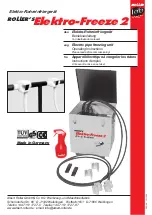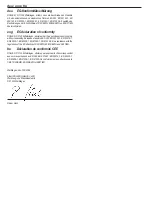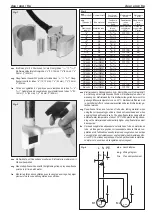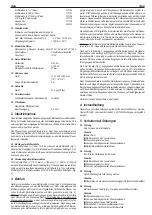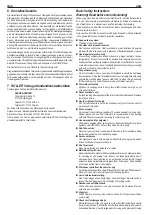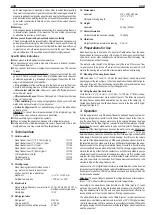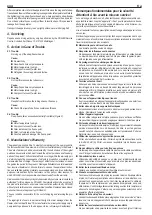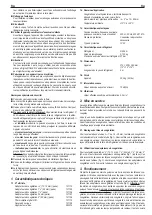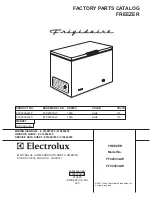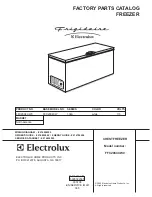
parts, breakage of parts, mounting, and any other condition that may affect
the power tool's operation. A guard or other part that is damaged should be
properly repaired or replaced by an authorised service facility unless other-
wise indicated in the operating instructions. Have defective switches replace
by an authorised service facility. Do not use the unit if the switch does not
turn it on and off.
·
Warning
Only use genuine spare parts and accessories, for personal safety reasons,
to ensure correct operation of the machine. The use of other accessories
or attachments involves a risk of injury.
·
Have your unit repaired by an authorised service facility
This unit complies with the relevant safety. All maintenance and repair work,
particularly when involving the electrical systems, must be performed only
by specialist personnel or by persons familiar with the machine and by using
original spare parts, otherwise injuries may result to the user. All unautho-
rised modifications of the machine are prohibited for safety reasons.
Specific Safety Instructions
·
Wear gloves suitable against cold temperatures.
·
Ice causes burns upon contact with skin. After work is finished, let deep-
freezer heads thaw out.
·
Do not bend or twist hoses or subject them to tensile stress. This can lead
to leaks.
·
Do not open up the refrigerant circuit. The apparatus contains the refri-
gerant R 404A in a closed circuit. Should refrigerant leak out in the event
of defective apparatus (e.g. breakage of a refrigerant hose), then the follo-
wing must be taken into consideration:
– Do not inhale: Get those affected into the fresh air and let them rest.
Should their breathing stop, use artificial respiration and call a physician.
– After contact with the skin: Thaw out or wash off affected portions of
skin with warm water.
– After contact with eyes: Rinse out thoroughly for 10 minutes with clean
water; call a physician.
– After swallowing: Do not induce regurgitation. Wash out mouth with
water, drink a glass of water. Go to a physician.
– Notice for physician: Do not administer any drugs of the Ephedrine /
adrenalin group.
Attention: In case of thermal decomposition of the refrigerant (e.g. fire)
highly noxious and corrosive vapours are generated.
·
Observe safety tips for refrigeration systems.
·
When scrapping the apparatus, dispose of the refrigerant properly.
·
Refrigerant may not be allowed to get into sewers, basements or work pits.
Refrigerant vapours may create a suffocating atmosphere.
1. Technical data
1.1. Article numbers
Deep freezer insert
1
/
8
(10, 12 mm) (pair)
131110
Deep freezer insert 1
1
/
4
(42 mm) (pair)
131155
Deep freezer insert 1
1
/
2
(pair)
131156
Deep freezer insert 54 mm (pair)
131157
Deep freezer insert 2
(60 mm) (pair)
131158
LCD digital thermometer
131115
Tightening strap
131104
Water squirt bottle
093010
1.2. Working range
Deep freezing liquids of all kinds such as,
e.g. water, milk, beer in tubes of steel,
copper, cast iron, lead, aluminium,
plastic, etc
1
/
8
–2
or 10–60 mm
Ambient temperature
+10°C up to +32°C
1.3. Electric data
Rated voltage, frequency, power, current
230 V~; 50 Hz, 430 W; 1.81 A
Safety class 1
Earthed conductor required
Safety type
IP 33
1.4. Refrigerant data
Refrigerant
R 404 A
Volume quantity
0.150 kg
Refrigerant circuit operating pressure
27 bar
1.5. Dimensions
Apparatus
310 × 305 × 360 mm
(12
× 12
× 14
)
Refrigerant hosing length
2 m
1.6. Weight
Apparatus
22.3 kg (50 lbs)
1.7. Noise information
Workplace-related emission reading
70 dB(A)
1.8. Vibrations
Weighted effective acceleration reading
2.5 m/s²
2. Preparations for Use
Deep freezing occurs by means of a transfer of refrigeration from the deep-
freezer heads to the outer surface of the tubing. To ensure good contact tran-
sition, paint, rust or other pollutants should be removed from the tubing. De-
formed tubes cannot be frozen up.
The water (or other liquid) in the tubing can only freeze up if there is no flow,
i.e. pumps should be turned off, water removal should be avoided. Cool off
water in the heating tubes to ambient temperature before deep freezing.
2.1. Mounting of the deep freeze heads
With tube sizes
1
/
4
–1
resp. 14–35 mm the deep-freezer heads are placed
directly against the tube (Figure 1). Fasten deep-freezer heads with the tighte-
ning strap (Figure 2). Shortest freezing times will be achieved when the hose
connector at the deep-freezer head is pointing upwards.
2.2. Using the deep freezer inserts
For tube sizes
1
/
8
(10, 12 mm), 1
1
/
4
(42 mm), 1
1
/
2
, 54 mm, 2
(60 mm) deep-
freezer inserts (accessories) are required (Figure 1). The latter are placed in
the deep-freezer heads. Each application can be seen in the table (Fig. 3).
Fasten deep-freezer heads with deep-freezer inserts to the tube with the tigh-
tening strap (Figure 2).
3. Operation
Turn the apparatus on only if the deep-freezer heads have been mounted. For
improving refrigeration transfer from the deep freezer heads to the tube, du-
ring the deep freezing process water should be sprayed between the deep
freezer head and the tube (Figure 2) several times with the water squirt bottle.
Important: It does not make sense to spray onto the point of freezing at the
beginning of the freezing process because the water runs away. When deep
freezing begins, water should be sprayed intensively in order to fill the gap
between the deep-freezer head and the pipe. If not followed, higher deep-freeze
times apply. After a certain period of deep freezing, frost forms on the tube in
the vicinity of the deep-freezer heads. When using the deep-freezer inserts for
the larger tubing sizes, make sure to spray until the transition between the deep-
freezer insert and the tubing is completely frozen. Should this frost formation
not occur within the period given in the table, then this strongly suggests flowing
water in the tubing or that the tube contents are hot. Where applicable, pumps
should be turned off, prevent water leakage, let water cool off. In addition, take
care that the deep-freezer heads are not subjected to solar radiation or hot air
draughts. In particular, air emissions from the apparatus valves should not be
allowed to blow on the deep-freezer point.
As accessories, LCD digital thermometers are available which can be inserted
into pockets on the tightening strap and which facilitate assessment of the deep-
freezer point's condition. The thermometers are driven by a battery which can
be replaced as needed.
Attention: The deep-freezer heads and the refrigerant hoses attain tempera-
tures of –30°C. Wear suitable gloves against cold temperatures.
According to the deep-freeze times indicated in the Table (Figure 3), repair
work can be done on the tubing. Before beginning repair work, check if the tu-
bing has depressurised. For this purpose, open any eventual let-off valves or
loosen a fastener. Do not turn apparatus off during repair process.
The deep-freeze times indicated in the Table (Figure 3) are ball-park values
and apply at an ambient / water temperature of about 20°C. At higher ambient
/ water temperatures, the time periods are accordingly extended. With plastic
tubing depending on the material used, substantially higher deep-freeze times
must be expected.
eng
eng

